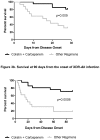Epidemiology, clinical characteristics and outcomes of extensively drug-resistant Acinetobacter baumannii infections among solid organ transplant recipients
- PMID: 23285002
- PMCID: PMC3527518
- DOI: 10.1371/journal.pone.0052349
Epidemiology, clinical characteristics and outcomes of extensively drug-resistant Acinetobacter baumannii infections among solid organ transplant recipients
Abstract
Background: Extensively drug-resistant Acinetobacter baumannii (XDR-Ab) has emerged as a major nosocomial pathogen, but optimal treatment regimens are unknown. Although solid organ transplant (SOT) recipients are particularly susceptible to XDR-Ab infections, studies in this population are limited. Our objectives were to determine the epidemiology, clinical characteristics and outcomes of XDR-Ab infections among SOT patients.
Methods: A retrospective study of SOT recipients at our center who were colonized or infected with XDR-Ab between November 2006 and December 2011 was conducted. Among infected patients, the primary outcome was survival at 28 days. Secondary outcomes included survival at 90 days and clinical success at 28 days, and XDR-Ab infection recurrence.
Results: XDR-Ab was isolated from 69 SOT patients, of whom 41% (28) and 59% (41) were colonized and infected, respectively. Infections were significantly more common among cardiothoracic than abdominal transplant recipients (p=0.0004). Ninety-eight percent (40/41) of patients had respiratory tract infections, most commonly ventilator-associated pneumonia (VAP; 88% [36/41]). Survival rates at 28 and 90 days were 54% (22/41) and 46% (19/41), respectively. Treatment with a colistin-carbapenem regimen was an independent predictor of 28-day survival (p=0.01; odds ratio=7.88 [95% CI: 1.60-38.76]). Clinical success at 28 days was achieved in 49% (18/37) of patients who received antimicrobial therapy, but 44% (8/18) of successes were associated with infection recurrence within 3 months. Colistin resistance emerged in 18% (2/11) and 100% (3/3) of patients treated with colistin-carbapenem and colistin-tigecycline, respectively (p=0.03).
Conclusions: XDR-Ab causes VAP and other respiratory infections following SOT that are associated with significant recurrence and mortality rates. Cardiothoracic transplant recipients are at greatest risk. Results from this retrospective study suggest that colistin-carbapenem combinations may result in improved clinical responses and survival compared to other regimens and may also limit the emergence of colistin resistance.
Conflict of interest statement
Figures



Similar articles
-
Colistin-based treatment for extensively drug-resistant Acinetobacter baumannii pneumonia.Int J Antimicrob Agents. 2014 Apr;43(4):378-82. doi: 10.1016/j.ijantimicag.2014.01.016. Epub 2014 Feb 14. Int J Antimicrob Agents. 2014. PMID: 24613422
-
Clinical epidemiology, treatment and prognostic factors of extensively drug-resistant Acinetobacter baumannii ventilator-associated pneumonia in critically ill patients.Int J Antimicrob Agents. 2016 Nov;48(5):492-497. doi: 10.1016/j.ijantimicag.2016.07.007. Epub 2016 Aug 12. Int J Antimicrob Agents. 2016. PMID: 27542315
-
Acinetobacter baumannii infection in solid organ transplant recipients.Clin Transplant. 2015 Mar;29(3):227-32. doi: 10.1111/ctr.12508. Epub 2015 Jan 30. Clin Transplant. 2015. PMID: 25580999
-
Treatment options for carbapenem-resistant and extensively drug-resistant Acinetobacter baumannii infections.Drugs. 2014 Aug;74(12):1315-33. doi: 10.1007/s40265-014-0267-8. Drugs. 2014. PMID: 25091170 Free PMC article. Review.
-
Recipient-born bloodstream infection due to extensively drug-resistant Acinetobacter baumannii after emergency heart transplant: report of a case and review of the literature.Infection. 2015 Oct;43(5):609-13. doi: 10.1007/s15010-015-0772-z. Epub 2015 Apr 1. Infection. 2015. PMID: 25828937 Review.
Cited by
-
Polymyxin combinations: pharmacokinetics and pharmacodynamics for rationale use.Pharmacotherapy. 2015 Jan;35(1):34-42. doi: 10.1002/phar.1537. Pharmacotherapy. 2015. PMID: 25630411 Free PMC article. Review.
-
Distribution and resistance of pathogens in liver transplant recipients with Acinetobacter baumannii infection.Ther Clin Risk Manag. 2015 Mar 26;11:501-5. doi: 10.2147/TCRM.S82251. eCollection 2015. Ther Clin Risk Manag. 2015. PMID: 25848296 Free PMC article.
-
The prevention and management of infections due to multidrug resistant organisms in haematology patients.Br J Clin Pharmacol. 2015 Feb;79(2):195-207. doi: 10.1111/bcp.12310. Br J Clin Pharmacol. 2015. PMID: 24341410 Free PMC article. Review.
-
Outer membrane protein A (OmpA) as a potential therapeutic target for Acinetobacter baumannii infection.J Biomed Sci. 2020 Jan 18;27(1):26. doi: 10.1186/s12929-020-0617-7. J Biomed Sci. 2020. PMID: 31954394 Free PMC article. Review.
-
Efflux Pump Inhibitor Phenylalanine-Arginine Β-Naphthylamide Effect on the Minimum Inhibitory Concentration of Imipenem in Acinetobacter baumannii Strains Isolated From Hospitalized Patients in Shahid Motahari Burn Hospital, Tehran, Iran.Jundishapur J Microbiol. 2015 Oct 12;8(10):e19048. doi: 10.5812/jjm.19048. eCollection 2015 Oct. Jundishapur J Microbiol. 2015. PMID: 26568800 Free PMC article.
References
-
- Saner FH, Olde Damink SW, Pavlakovic G, van den Broek MA, Rath PM, et al. (2008) Pulmonary and blood stream infections in adult living donor and cadaveric liver transplant patients. Transplantation 85: 1564–1568. - PubMed
-
- Benden C, Aurora P, Edwards LB, Kucheryavaya AY, Christie JD, et al. (2011) The Registry of the International Society for Heart and Lung Transplantation: Fourteenth Pediatric Lung and Heart-Lung Transplantation Report–2011. J Heart Lung Transplant 30: 1123–1132. - PubMed
-
- Boucher HW, Talbot GH, Bradley JS, Edwards JE Jr, Gilbert D, et al. (2009) Bad bugs, no drugs: No ESKAPE! An update from the Infectious Diseases Society of America. Clin Infect Dis 48: 1–12. - PubMed
-
- Shields RK, Kwak EJ, Potoski BA, Doi Y, Adams-Haduch JM, et al. (2011) High mortality rates among solid organ transplant recipients infected with extensively drug-resistant Acinetobacter baumannii: using in vitro antibiotic combination testing to identify the combination of a carbapenem and colistin as an effective treatment regimen. Diagn Microbiol Infect Dis 70: 246–252. - PubMed
-
- Reddy P, Zembower TR, Ison MG, Baker TA, Stosor V (2010) Carbapenem-resistant Acinetobacter baumannii infections after organ transplantation. Transpl Infect Dis 12: 87–93. - PubMed
Publication types
MeSH terms
Substances
Grants and funding
LinkOut - more resources
Full Text Sources
Medical

